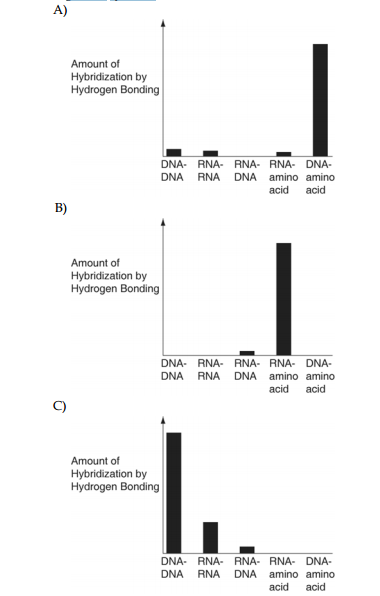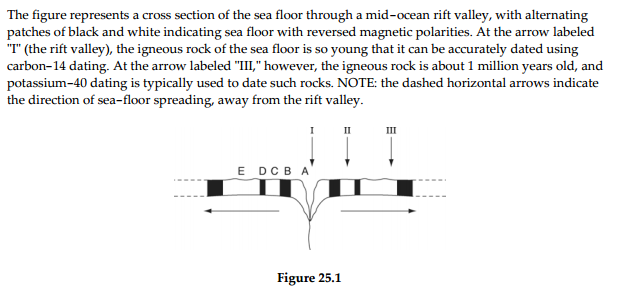Instructions for Side by Side Printing
- Print the notecards
- Fold each page in half along the solid vertical line
- Cut out the notecards by cutting along each horizontal dotted line
- Optional: Glue, tape or staple the ends of each notecard together
AP Biology Chapter 25
front 1 Which gas was least abundant in Earthʹs early atmosphere, prior to 2
billion years ago? | back 1 A |
front 2 In their laboratory simulations of the early Earth, Miller and Urey
observed the abiotic | back 2 A |
front 3 Which of the factors below weaken the hypothesis of abiotic synthesis
of organic monomers | back 3 D |
front 4 ) Which of the following has not yet been synthesized in laboratory
experiments studying | back 4 D |
front 5 In what way were conditions on the early Earth of more than 3 billion
years ago different | back 5 B |
front 6 What is true of the amino acids that might have been delivered to
Earth within | back 6 B |
front 7 Which of the following is the correct sequence of these events in the
origin of life? | back 7 C |
front 8 Which is a defining characteristic that all protobionts had in
common? | back 8 B |
front 9 Although absolute distinctions between the ʺmost evolvedʺ protobiont
and the first living | back 9 D |
front 10 The first genes on Earth were probably | back 10 C |
front 11 RNA molecules can both carry genetic information and be catalytic.
This supports the | back 11 A |
front 12 What probably accounts for the switch to DNA-based genetic systems
during the evolution | back 12 A |
front 13 The synthesis of new DNA requires the prior existence of
oligonucleotides to serve as | back 13 B |
front 14 Several scientific laboratories across the globe are involved in
research concerning the | back 14 C |
front 15  ) Several scientific laboratories across the globe are involved in
research concerning the | back 15 B |
front 16 If natural selection in a particular environment favored genetic
systems that permitted the | back 16 D |
front 17 If relatively small carbonaceous chondrites from space were a
significant source of Earthʹs | back 17 C |
front 18 If the half-life of carbon-14 is about 5,730 years, then a fossil
that has one-sixteenth the | back 18 E |
front 19 Which measurement would help determine absolute dates by radiometric
means? | back 19 E |
front 20 How many half-lives should have elapsed if 6.25% of the parent
isotope remains in a fossil | back 20 D |
front 21 Approximately how far back in time does the fossil record
extend? | back 21 D |
front 22  ) Assuming that the rate of sea-floor spreading was constant during
the 1-million-year | back 22 D |
front 23  If a particular marine organism is fossilized in the sediments
immediately overlying the | back 23 C |
front 24  Earthʹs current magnetic field is the same as it had been when which
sea-floor areas | back 24 E |
front 25  Assuming that the rate of sea-floor spreading was constant during the
1-million-year | back 25 C |
front 26 Argon-40, the daughter isotope of potassium-40, is a gas. Elemental
potassium has an | back 26 D |
front 27 What is true of the fossil record of mammalian origins? | back 27 C |
front 28 If a fossil is encased in a stratum of sedimentary rock without any
strata of igneous rock | back 28 D |
front 29 Letʹs say that a hypothetical submersible robot was used to collect
samples of sedimentary | back 29 E |
front 30 An early consequence of the release of oxygen gas by plant and
bacterial photosynthesis | back 30 D |
front 31 Arrange these events from earliest to most recent. | back 31 B |
front 32 ) Which free-living cells were the earliest contributors to the
formation of Earthʹs oxidizing | back 32 A |
front 33 Which of the following statements provides the strongest evidence
that prokaryotes | back 33 E |
front 34 What is thought to be the correct sequence of these events, from
earliest to most recent, in | back 34 C |
front 35 If it were possible to conduct sophisticated microscopic and chemical
analyses of | back 35 C |
front 36 Recent evidence indicates that the first major diversification of
multicellular eukaryotes | back 36 C |
front 37 Which of these observations fails to support the endosymbiotic theory
for the origin of | back 37 A |
front 38 ) Which event is nearest in time to the end of the period known as
snowball Earth? | back 38 C |
front 39 The snowball Earth hypothesis provides a possible explanation for
the | back 39 A |
front 40 If two continental land masses converge and are united, then the
collision should cause | back 40 A |
front 41 A major evolutionary episode that corresponds in time most closely
with the formation of | back 41 C |
front 42 On the basis of their morphologies, how might Linnaeus have
classified the Hawaiian | back 42 C |
front 43  Anatomically, what was true of Lystrosaurus? | back 43 B |
front 44  Which of Lystrosaurusʹ features help explain why these organisms
fossilized so abundantly? | back 44 D |
front 45  Which of these is the most likely explanation for the modern-day
distribution of | back 45 C |
front 46  ) The observation that tusks were limited to males in several
species, and were apparently | back 46 E |
front 47  Which of these is the most likely explanation for the existence of
dicynodont fossils on | back 47 C |
front 48  Dicynodonts survived the Permian extinction and, therefore, existed
during both the | back 48 A |
front 49  ) There are at least a dozen known species in the extinct genus
Lystrosaurus. If each species | back 49 B |
front 50  0) The dicynodonts survived the mass extinction that was most closely
correlated in time, if | back 50 D |
front 51  The dicynodonts that survived the Permian extinction would initially
have had to endure | back 51 E |
front 52  If an increase in dicynodont species diversity (i.e., number of
species) occurred soon after | back 52 B |
front 53 Fossilized stromatolites | back 53 C |
front 54 ) The oxygen revolution changed Earthʹs environment dramatically.
Which of the following | back 54 A |
front 55 Select the factor most likely to have caused the animals and plants
of India to differ greatly | back 55 E |
front 56 Adaptive radiations can be a direct consequence of four of the
following five factors. Select | back 56 B |
front 57 A genetic change that caused a certain Hox gene to be expressed along
the tip of a | back 57 C |
front 58 Which of the following steps has not yet been accomplished by
scientists studying the | back 58 D |
front 59 A swim bladder is a gas-filled sac that helps fish maintain buoyancy.
The evolution of the | back 59 C |